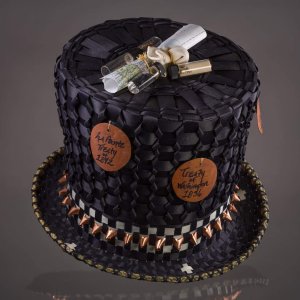Presented By: Penny W Stamps School of Art & Design
Penny Stamps Speaker Series - Kelly Church
Sustaining Traditions

Kelly Church is an Ottawa and Pottawatomi artist belonging to the Matchi-be-nash-she-wish tribe in Hopkins, MI. A member of the Gun Lake Band in Michigan and a Grand Traverse Band of Ottawa and Ojibwe descendent, she comes from an unbroken line of black ash basket makers and from the largest black ash weaving family in the Great Lakes region. Her artistic journey is deeply intertwined with the woodlands and forests of Michigan, where she harvests and works with a variety of natural fibers including black ash, birch bark, cedar bark, spruce roots, and basswood. These materials serve as the foundation for her distinctive woven sculptures, each meticulously crafted and adorned with copper and silver embellishments.
With her relatives’ guidance, Church learned to select the best black ash tree in order to provide the best material to create everything from utilitarian baskets to more conceptual weavings. Each tree she harvests and transforms into a basket tells a story, just as those before her created baskets that told their own stories. She has learned firsthand how the process of weaving a black ash basket is not only about weaving, it is also about biochemistry, forest management, pest control, Indigenous language, family history, and deep, ancient connections to the landscape from which her people originate.
In 2002 Church learned about the Emerald Ash Borer (EAB) and was rightfully alarmed. This invasive and voracious black ash tree bug from Asia has no known predators and the USDA has predicted the entire ash resource of North America will be lost to it. She was galvanized to do something about it and began researching, documenting, collecting seeds, and collaborating with national and international agencies in getting the word out about this environmental and cultural disaster.
Church’s journey as an advocate for the survival of Native traditions and the black ash tree has involved many national and international art programs, exhibitions, and partnerships with government agencies such as tribal offices and the US Forest Service. She has received multiple honors and awards, including being named a National Endowment for the Arts National Heritage Fellow, earning a Native Arts and Cultures Foundation’s National Artist Fellowship, and has been a four-time Artist Leadership Program participant of the Smithsonian National Museum of the American Indian. Her artwork has been exhibited and purchased by both public and private collectors around the world.
Church says, “It’s the teachings that have been sustained and passed on before this country existed that keep this art alive. These weavings tell a story of time, place, and in the future will serve as a record of history.”
Presented in partnership with the Stamps Gallery on the opening of the exhibition Kelly Church & Cherish Parrish: In Our Words, An Intergenerational Dialogue, centering the subjectivities of two contemporary Indigenous artists whose practices have sustained and bolstered the relevance of the age-old Anishinaabe practice of black ash basket-making in the 21st century. This project was made possible by a grant from the Arts Initiative at the University of Michigan.
Series presenting partners: Detroit PBS and PBS Books. Media partner: Michigan Radio.
With her relatives’ guidance, Church learned to select the best black ash tree in order to provide the best material to create everything from utilitarian baskets to more conceptual weavings. Each tree she harvests and transforms into a basket tells a story, just as those before her created baskets that told their own stories. She has learned firsthand how the process of weaving a black ash basket is not only about weaving, it is also about biochemistry, forest management, pest control, Indigenous language, family history, and deep, ancient connections to the landscape from which her people originate.
In 2002 Church learned about the Emerald Ash Borer (EAB) and was rightfully alarmed. This invasive and voracious black ash tree bug from Asia has no known predators and the USDA has predicted the entire ash resource of North America will be lost to it. She was galvanized to do something about it and began researching, documenting, collecting seeds, and collaborating with national and international agencies in getting the word out about this environmental and cultural disaster.
Church’s journey as an advocate for the survival of Native traditions and the black ash tree has involved many national and international art programs, exhibitions, and partnerships with government agencies such as tribal offices and the US Forest Service. She has received multiple honors and awards, including being named a National Endowment for the Arts National Heritage Fellow, earning a Native Arts and Cultures Foundation’s National Artist Fellowship, and has been a four-time Artist Leadership Program participant of the Smithsonian National Museum of the American Indian. Her artwork has been exhibited and purchased by both public and private collectors around the world.
Church says, “It’s the teachings that have been sustained and passed on before this country existed that keep this art alive. These weavings tell a story of time, place, and in the future will serve as a record of history.”
Presented in partnership with the Stamps Gallery on the opening of the exhibition Kelly Church & Cherish Parrish: In Our Words, An Intergenerational Dialogue, centering the subjectivities of two contemporary Indigenous artists whose practices have sustained and bolstered the relevance of the age-old Anishinaabe practice of black ash basket-making in the 21st century. This project was made possible by a grant from the Arts Initiative at the University of Michigan.
Series presenting partners: Detroit PBS and PBS Books. Media partner: Michigan Radio.